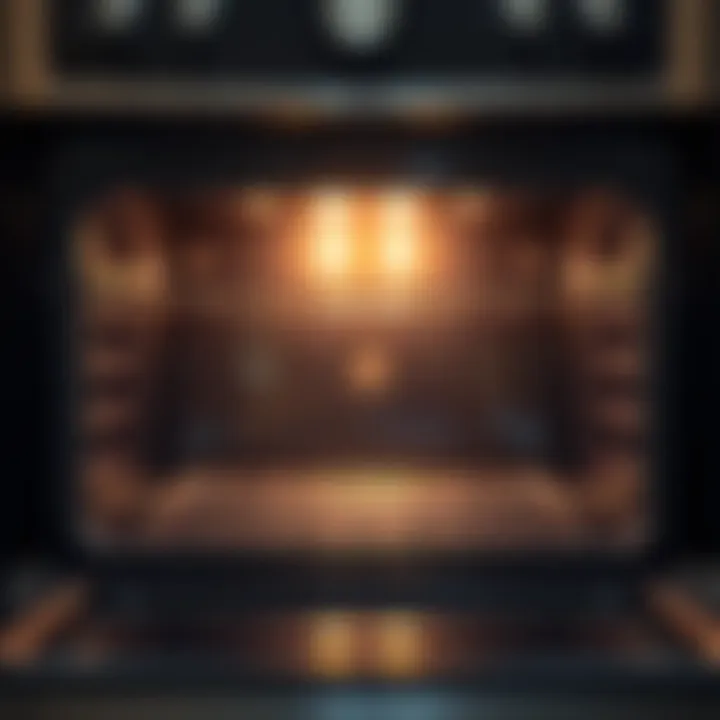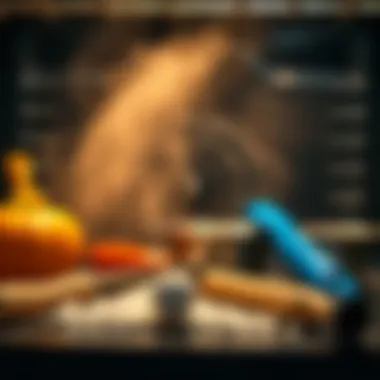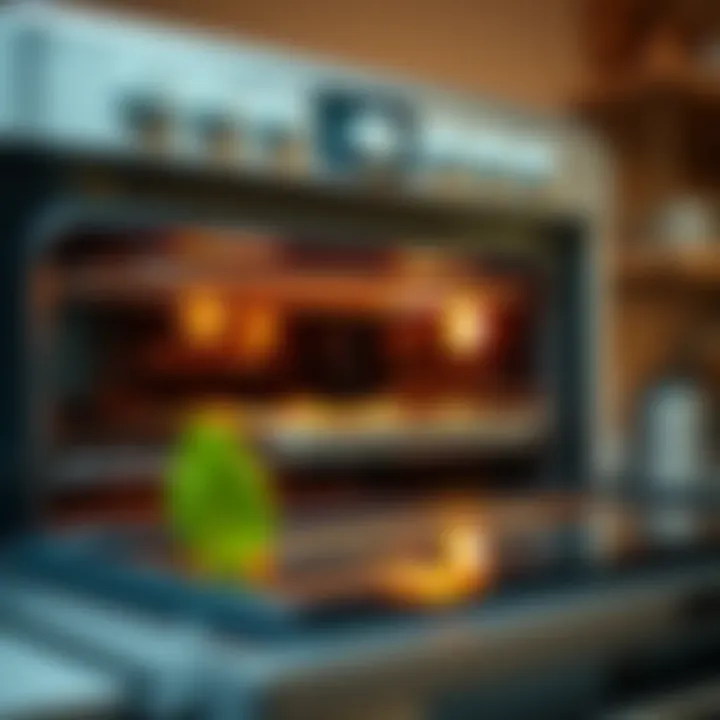Eco-Friendly Oven Cleaning Techniques for a Sparkling Finish


Intro
Cleaning an oven can feel like a daunting task, especially when faced with caked-on grease and stubborn stains. Yet, it’s essential for maintaining a hygienic kitchen environment and ensuring that your culinary creations don’t taste like last week’s dinner. Many people think that the only way to tackle this challenge is to load up on commercial cleaning products packed with harsh chemicals.
However, there’s a better way that’s not only gentler on the environment but also on your health. Embracing natural cleaning methods can transform your oven-cleaning routine into a simpler, safer task. From baking soda to vinegar, these common household items can work wonders without exposing you to strong fumes or chemicals.
This guide will delve into effective, eco-friendly approaches to restoring your oven's sparkling clean finish. Even if you’re not an experienced chef, these methods are straightforward — perfect for anyone looking to elevate their kitchen maintenance game. Expect practical techniques, informative tips, and a little innovation, all to help keep your oven in tip-top shape without resorting to harmful cleaners.
Understanding the Need for Chemical-Free Cleaning
In a world where convenience often reigns supreme, the cleaning aisle of stores teems with chemical-based solutions promising quick fixes for every kind of mess. But, have you ever stopped to consider the true impact of these products not just on your health, but on the environment?
Many of these chemical cleaners carry a laundry list of risks. They can emit harmful fumes that linger long after cleaning is done. Breathing in these toxins can lead to respiratory issues, skin irritations, and even more serious health problems over time. Beyond personal health, the environmental effects can’t be overlooked either. Many chemicals wash down our drains and eventually affect waterways, polluting ecosystems crucial for countless species. The need for a chemical-free approach to cleaning has never been more clear.
"Cleanliness is not just about the absence of dirt; it’s about maintaining a healthy and safe space for yourself and your environment."
The Risks of Chemical Cleaners
When we think about how we keep our kitchens clean, especially when dealing with tough spots like the oven, it’s easy to reach for products filled with harsh chemicals. These cleaners often contain ingredients like ammonia or bleach that can be hazardous. Not only do they pose health risks, they're also harmful to surfaces and can lead to premature wear and tear on your appliances.
- Respiratory irritation: The fumes can linger long after application, causing discomfort and potential long-term damage.
- Skin reactions: Direct contact with these chemicals can result in irritations or burns.
- Environmental harm: Wastewater from chemical cleaners can have devastating effects on aquatic life and must be treated properly before disposal.
In consumer society, it’s tempting to overlook these warnings for the sake of efficiency. However, understanding these risks encourages a shift towards more sustainable practices.
Benefits of Natural Cleaning Solutions
Choosing natural cleaning solutions comes with a boatload of benefits. Not only are they safer for your health, they often perform surprisingly well against grease and grime. Simple ingredients found in most kitchens can transform cleaning into an easy and effective task.
- Safety: Natural cleaning agents like baking soda, vinegar, and lemon juice are non-toxic and safe for use around children and pets.
- Cost-Effective: You can often make these solutions at home for a fraction of the cost of commercial cleaners.
- Effective Cleaning: Many natural cleaners are just as effective, if not more so, than chemical alternatives. For example, vinegar can cut through grease effectively, especially when combined with baking soda.
- Environmental Stewardship: Using natural materials reduces chemical runoff into our environment, thereby contributing to a healthier planet.
As we delve deeper into specific techniques and methods of cleaning ovens naturally, it's essential to remember that every little bit counts. Changing our habits not only improves the cleanliness of our homes but also fosters a healthier relationship with our world. By embracing chemical-free cleaning, we position ourselves as responsible stewards of both our health and the environment, while achieving a clean and sparkling kitchen.
Essential Tools for a Chemical-Free Clean
When it comes to cleaning an oven without resorting to harsh chemicals, the right tools play a pivotal role. Not only do appropriate cleaning tools enhance the effectiveness of natural cleaning methods, but they also ensure safety and ease of use. Moreover, using non-toxic materials aligns with a growing awareness of environmentally friendly practices at home.
Basic Cleaning Tools
Soft Cloths
Soft cloths are a staple in any cleaning kit, especially when tackling the delicate surfaces of an oven. Their importance lies in their ability to absorb liquids and remove residues without scratching or damaging the finish. Many people prefer microfiber or cotton because these materials trap dirt and grease with ease.
A significant characteristic of soft cloths is their gentle texture. This minimizes any risk of scratching while effectively lifting grime. Moreover, they are reusable and machine washable, making them an eco-friendly choice. However, it's important to ensure they are clean before use to avoid reintroducing dirt or bacteria.
Sponge
Sponge, another essential tool, has a unique feature: its dual surface. One side is soft and absorbent, perfect for wiping down surfaces, while the other side is often rough, designed for scrubbing tough stains. This versatility makes sponges ideal for various cleaning tasks within the oven.
Their key characteristic is their ability to hold water and cleaning solution, which aids in breaking down grease and baked-on food. However, sponges can harbor bacteria if not regularly sanitized, so it's important to change them frequently and ensure they dry properly after each use.
Scrubbing Brush
For those stubborn areas where grease has built up, a scrubbing brush is a lifesaver. Its bristles can reach into crevices that other tools may miss, making it a valuable addition to your cleaning arsenal. These brushes come in various shapes and sizes, allowing for targeted cleaning.
A scrubbing brush's defining feature is its ability to apply more pressure without worry of damage, especially when you choose one with softer bristles. It's beneficial for deep cleanings but can sometimes take more effort than other tools. Being mindful of how much force you exert will help prevent any possible scratching on sensitive surfaces.


Natural Cleaning Agents
Baking Soda
Baking soda is a superstar in the world of natural cleaning agents. Its gentle abrasive nature combined with its ability to neutralize odors makes it perfect for oven cleaning. When mixed with water, it forms a paste that clings to surfaces, allowing time for it to break down grime.
A key characteristic of baking soda is its non-toxic nature. It's safe around food and pets, making it a favored choice amongst health-conscious households. The only drawback is that it may require a bit of scrubbing, especially on heavily soiled spots.
Vinegar
Vinegar, a kitchen staple, is remarkable for its ability to cut through grease and grime. Its acidity works wonders in breaking down built-up residues, and when used alongside baking soda, the two create a powerful cleaning reaction that lifts dirt effortlessly.
Its standout feature is its natural deodorizing properties. Vinegar eliminates odors rather than masking them, which is a tremendous advantage for maintaining an odor-free cooking environment. However, the strong scent might not be to everyone's liking, but it dissipates quickly.
Lemon Juice
Using lemon juice not only adds a fresh scent but also brings antibacterial properties into the mix. High in citric acid, it is effective in breaking down tough grime and leaving surfaces sparkling. Plus, it imparts a pleasant aroma, which makes cleaning a bit more enjoyable.
What sets lemon juice apart is its ability to act as both a cleaner and a freshening agent. It’s especially useful in whitening surfaces and leaves a cheery scent behind. However, like vinegar, it may not be suitable for all surfaces, as the acidity can damage certain finishes.
Optional Tools for Efficiency
Steam Cleaner
A steam cleaner can be a game changer for those seeking a deeper clean without chemicals. It uses high-temperature steam to loosen dirt and grime, making it easier to wipe away. This tool is, therefore, incredibly effective for tough oven messes without the need for added chemicals.
The biggest benefit of steam cleaners is their efficiency; they can eliminate 99.9% of bacteria and germs without any harsh substances. However, they can be costly, and not everyone may want to invest in a new appliance for occasional use, especially if lighter cleaning is sufficient.
Microfiber Cloths
Microfiber cloths are incredibly popular in the cleaning community for several excellent reasons. They are highly absorbent and can trap particles far better than traditional cloths. This means they often require less scrubbing and lead to faster results during your cleanup efforts.
A unique feature of microfiber cloths is their ability to clean with just water, removing dirt without leaving streaks. They are reusable and washable, making them an economical choice in the long run. Just be careful to wash them properly to maintain their effectiveness.
Oil Spray Bottle
An oil spray bottle can be a handy addition for those who like to maintain their oven. Using a light coating of oil can prevent stuck-on messes and create an easy-to-clean surface. It’s a simple, yet effective way to keep your oven in shape, as long as the oil is applied sparingly.
The distinct characteristic of an oil spray bottle is its capacity to distribute a fine mist, allowing for even coverage. It’s particularly useful when roasting, as it applies a thin layer rather than soaking the food. The downside is that if used too liberally, it can lead to excessive grease accumulation, making subsequent cleanings more difficult.
Preparing the Oven for Cleaning
Cleaning an oven is no small feat, especially if you're aiming to do it without using any harsh chemicals. Preparation is a crucial part of this process, ensuring that you not only get the best results but also create a clean and safe cooking environment. Before diving headfirst into scrubbing and polishing, there are a few considerations that lay the groundwork for a successful clean.
Safety Precautions
Before rolling up your sleeves, safety should be your first priority. While natural cleaning agents like baking soda and vinegar are generally safe, there are still common-sense steps to consider:
- Turn Off and Unplug the Oven: Always make sure your oven is turned off and completely cool before starting the clean-up process. Unplugging provides an extra level of safety, preventing any accidental activation.
- Wear Gloves: Though natural cleaners are milder, it doesn’t hurt to protect your hands. A pair of sturdy rubber gloves can shield your skin from any residue or grease.
- Ventilation is Key: Open windows or turn on a fan to keep the air circulating. This prevents any overwhelming scents from lingering in your kitchen.
Taking these precautions is more than just following a routine—it's about being proactive in ensuring your safety, which allows you to focus on the task at hand without any hiccups.


Clearing the Oven Interior
Once you've taken the necessary safety measures, the next step in preparing your oven for cleaning is to clear its interior. This might seem straightforward, but it’s an essential part of the process that can often be overlooked. It makes your cleaning attempts more effective and efficient. Here’s how to go about it:
- Remove Cookware and Racks: Take out any pots, pans, or baking sheets. Don't forget to remove the oven racks, as these can be cleaned separately for a deeper clean.
- Discard Food Debris: Inspect the bottom of the oven and walls for any bits of food or burnt crumbs. A quick sweep with a damp cloth can lift away much of the loose debris.
- Assess the Space: Take a moment to examine how dirty the oven is. If there are stubborn spots or major stains, you can treat these areas more deliberately with your natural cleaning agents when you begin the actual cleaning process.
By clearing out the oven, you're setting the stage for a more thorough clean. This preparation allows your natural cleaning efforts to be more effective, tackling grease and grime more efficiently.
Remember, a clean oven isn't just about appearance; it's about the performance of your cooking appliance and the safety of your meals.
Once you’ve completed these preparatory steps, you’ll be ready to transition into the actual cleaning process using those effective natural techniques that will leave your oven sparkling, all without resorting to any chemical cleaners.
Step-by-Step Natural Cleaning Methods
Cleaning an oven without chemicals is more than just a trend; it's an essential practice for maintaining a healthy kitchen environment. Utilizing step-by-step natural cleaning methods can not only ensure a spotless oven but also keep harmful substances at bay. Natural ingredients, such as baking soda, vinegar, and lemon juice, contribute to the cleaning process by breaking down grease and lifting burnt-on food without the harshness of chemical solutions.
This section lays out practical steps that can guide you through the entire process. Each method has unique advantages, highlights simplicity, and emphasizes sustainability. By understanding these approaches, you can achieve an effective clean while promoting a greener lifestyle.
Baking Soda Paste Application
Preparing the Paste
To prepare the paste, you need simple ingredients. It just takes a cup of baking soda and a few tablespoons of water. Mixing them creates a thick paste that’s perfect for scrubbing your oven. This paste is favored because baking soda acts as a mild abrasive, which means it can eliminate stubborn stains without scratching the surfaces. This gentle yet effective characteristic is crucial, especially for delicate oven interiors. While there are commercially available cleaners, many folks choose this homemade solution because it’s cost-effective and non-toxic.
Applying the Paste Effectively
When it comes to applying the paste, it’s best to focus on the most soiled areas first. Using a soft cloth or sponge, spread the paste generously over the grime, ensuring all corners are covered. This method is worthwhile because it allows the baking soda to penetrate and soften the stuck-on food. Remember, consistency is key; applying a uniform layer will enhance its effectiveness. It’s essential to avoid using metal sponges, as they can scratch your oven's surface.
Letting It Sit
After application, letting the paste sit for several hours, or even overnight, is critical. This waiting period allows the baking soda to break down grease and grime significantly. It’s like letting a fine wine breathe before serving; a little patience goes a long way. While you're resting, consider this time to prepare for the next cleaning steps. This approach not only delivers superior results but is a breeze, given how minimal effort is required during this stage.
Vinegar and Baking Soda Reaction
Creating the Reaction
Combining vinegar with the baking soda paste prompts a chemical reaction that releases carbon dioxide, which helps to lift dirt. This reaction creates effervescence, which is visually rewarding and practically beneficial. The fizzing action assists in loosening tough stains, making it easier to wipe away later. This reaction showcases how natural ingredients can work together to yield impressive results, a beneficial practice for those refraining from chemicals.
Observing the Break Down of Grease
As you observe the breakdown of grease after the reaction kicks in, you’ll notice the areas that are fading before your eyes. The bubbling of vinegar against the baking soda helps lift the residue off, making it a unique experience. It’s rewarding to watch tough spots begin to dissolve, signaling that your natural approach is working. Moreover, this visual feedback can encourage more natural cleaning methods in the future.
Cleaning It Up
Once the reaction has completed its course, cleaning it up is relatively straightforward. A damp cloth can effectively wipe away the remnants. Using your scrubbing brush or sponge, gently scrub the affected areas, removing any remnants left behind. It’s crucial to ensure no baking soda is left behind; otherwise, it can leave a residue that may require additional cleaning. The simplicity of this method promotes ease, encouraging a continual choice of natural cleaning solutions.
Using Lemon Juice
Extracting Juice
Extracting juice from fresh lemons is both refreshing and practical. For cleaning, you'll need about two to three lemons. Squeeze the juice into a bowl, ensuring you collect every drop. Lemon juice is often chosen for its acidic properties, which can cut through grease with ease. They also equip your cleaning with a pleasant scent, making the process somewhat enjoyable.


Application Techniques
Once you’ve extracted your lemon juice, applying it is simple. Dip a cloth in the juice and wipe down the oven surfaces. Areas with more grime may require additional applications. Utilizing lemon juice effectively combines citrus's natural antibacterial structure with its pleasant aroma. It’s a fantastic choice not only for cleaning the oven but also for freshening up the kitchen environment as a whole.
Benefits of Citrus Cleaning
Citrus cleaning provides multiple benefits. With lemon's natural oils and acids, you not only tackle grease but also leave surfaces gleaming. This option is particularly popular among those who value both cleanliness and fragrance in their kitchens. However, keep in mind that, depending on your oven’s material, citrus can sometimes cause discoloration, so always conduct a spot test before extensive use.
Natural cleaning methods preserve your health while keeping your kitchen sparkling clean and fresh.
Maintaining Your Oven After Cleaning
After putting in the elbow grease to clean your oven without resorting to harsh chemicals, it's crucial to think about maintaining its cleanliness. Regular upkeep not only preserves the shine of your appliance but also enhances its performance and longevity. An oven that's maintained properly can function more efficiently, saving energy and reducing the likelihood of future buildup. With this in mind, let’s delve into the specific strategies to keep your oven in top shape.
Regular Cleaning Routines
Establishing a routine is a vital part of maintaining your oven. Just like the old saying goes, "A stitch in time saves nine." Regular cleaning minimizes severe grime accumulation, making those deeper cleans less frequent and quicker to perform. Depending on how often you cook, a good practice is to give your oven a light cleaning once a week. Simply wipe down the surfaces and remove any spills that have occurred during the week. This doesn't have to take a lot of time. Just grab a soft cloth, some warm water, and your usual natural cleaning agents like baking soda or vinegar.
Also, consider setting up a monthly deep clean schedule. Use this time to make sure every nook and cranny is addressed, using the methods discussed previously in this guide. During this deep clean, focus on areas that are often neglected, such as the oven racks and the exterior surfaces. A thorough cleaning routine goes a long way in fostering a clean, efficient cooking environment.
Preventive Measures
To keep your oven in pristine condition, being proactive can make the world of difference. Here are some key preventive measures to consider:
Using Baking Sheets
One strong recommendation is to use baking sheets when cooking. These exceptional tools catch drips and spills, keeping your oven floor cleaner and reducing the amount of scrubbing you'll need later on. The beauty of using baking sheets is in their versatility; they come in many sizes and can be adapted to different kinds of dishes.
When you use them, just remember to line them with parchment paper for an even easier clean-up process. The key characteristic of baking sheets is how they act as a barrier between your food and oven surfaces. This not only protects your oven's interior but also significantly speeds up the cleaning process after cooking. Their only downside might be that they can take up space in cabinetry, but the savings in cleaning time justify that trade-off.
Monitoring Spills Promptly
Another key strategy in oven maintenance is to monitor spills promptly. It may not seem like a big deal at first, but a timely response can prevent a minor issue from turning into a major hassle down the line. Whenever something spills during cooking, it's best to address it right away.
Take a moment to wipe up spills with a damp cloth before they have a chance to bake onto the oven’s surfaces. This practice is helpful because it stops sticky substances from hardening, which would require more time and effort to remove later on. The unique advantage here is simplicity; it doesn’t require any special tools or cleaners—perhaps just your hand and a little bit of water. Sure, it may feel tedious to pause mid-cooking, but in the long run, you’ll thank yourself.
Now you don’t have to dread cleaning your oven as much, knowing that with a little regular maintenance and prompt actions, you can keep it looking fresh and in good working order.
Ending
Cleaning an oven without the use of harsh chemicals isn’t just a trend; it’s a necessity in many households today. This article underscores the importance of eco-friendly cleaning methods, spotlighting both their effectiveness and the health benefits they bring. Chemical cleaners may be quick fixes, but they often leave residues that can affect food safety and air quality. By embracing natural alternatives, individuals can maintain a cleaner kitchen while safeguarding their health and that of their loved ones.
Recap of Methods
Throughout this piece, we have navigated several effective techniques for keeping an oven clean without resorting to chemicals. Here’s a quick recap of the key methods discussed:
- Baking Soda Paste: Creating a paste with baking soda is an effective way to cut through stubborn grime. It’s not only safe but also highly efficient.
- Vinegar and Baking Soda Reaction: The fizzy reaction between these two natural elements can help break down grease and grime effortlessly.
- Lemon Juice: Its natural acidity not only cuts through dirt but also leaves a refreshing scent, enhancing the overall cleaning process.
Each method shines in its own way, emphasizing that cleaning doesn't need to come at the cost of health or the environment.
Encouragement for Natural Cleaning Practices
As we conclude, it’s crucial to encourage the shift towards natural cleaning practices. While it may take a little extra effort compared to grabbing a bottle off the shelf, the results are well worth it. One small change can make a significant impact on both personal health and the planet.
Consider this a gentle nudge to try these methods out for yourself. You might find that the simplicity and effectiveness of natural ingredients outclass their chemical counterparts. Moreover, adopting these practices promotes sustainability, allowing you to play a small yet significant role in reducing chemical pollution.
"By using natural cleaning methods, you not only foster a safer cooking environment but also contribute to a healthier planet."
So, roll up your sleeves and give these natural solutions a shot. A cleaner oven awaits without the need for harsh chemicals, ensuring your culinary space remains a haven for delicious creations.















